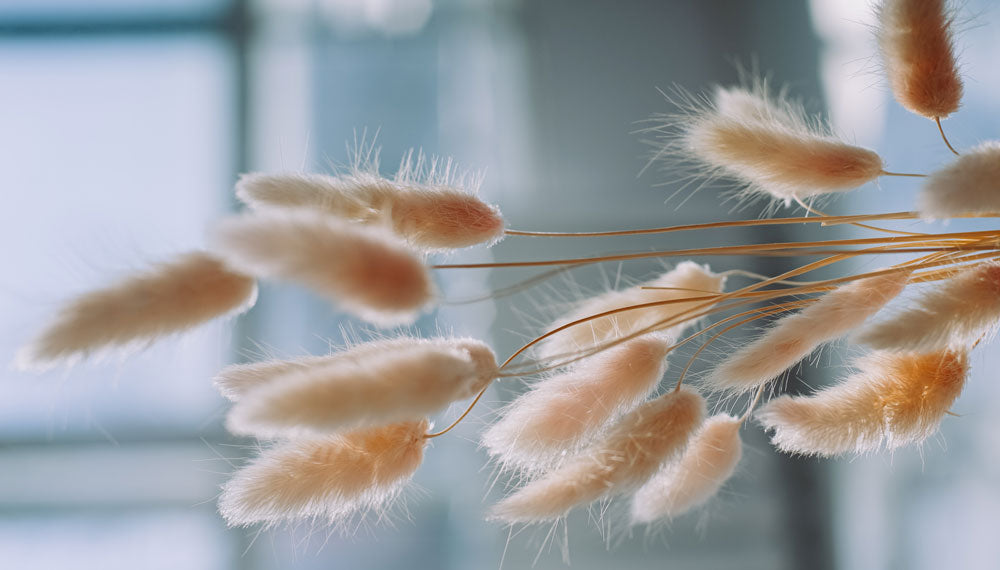Loved for its soft, fluffy texture and natural charm, Bunny Tails (Lagurus ovatus) are a go-to for stylists, florists, and creatives working with dried flowers. Its playful seed heads add gentle movement to bouquets, home décor, and seasonal displays. Plus, it’s surprisingly simple to grow yourself!
We’ve put together this expert guide to help you grow, harvest, care for, and style Bunny Tail Grass with confidence. From planting tips to wedding bouquet ideas, you’ll find everything you need to make the most of this beautifully versatile ornamental grass.
What Is Bunny Tail Grass?
Bunny Tail Grass (Lagurus ovatus) is a small annual grass recognised for its soft, oval seed heads that resemble a rabbit’s tail. Native to the Mediterranean and part of the Poaceae family, it’s become a well-loved feature in dried arrangements and natural-style interiors.
Botanical Background
As a species of ornamental grass, Lagurus ovatus grows to around 30–60cm tall. Its long, slender stems are topped with dense, fluffy flower heads known as inflorescences.
These start out pale green and gradually lighten to a creamy beige as they mature, a natural fade that continues as they dry.
The plant’s name comes from the shape and texture of its seed heads, which closely mimic the look of a rabbit’s tail. This soft, tactile quality is part of what makes Bunny Tails so appealing in both fresh and dried forms.
Fresh Versus Dried
Fresh Bunny Tail Grass adds texture and movement to gardens and borders in the summer months. Once dried, it becomes a long-lasting decorative stem used in floral styling, wreaths, and home accessories.
The dried form is particularly popular because it holds its shape and colour with minimal care.
This makes it a practical and sustainable alternative to fresh-cut flowers, especially for florists, event stylists, and home decorators looking for low-maintenance options that still feel special.
Where It’s Used
You’ll often see dried Bunny Tails in wedding bouquets, shelf styling, gift wrapping, and interior arrangements. Their neutral tones and soft shape work well with boho, minimalist, or seasonal themes.
Bunny Tails work well as standalone stems or as part of a wider mix, adding soft texture and movement without overpowering a display.
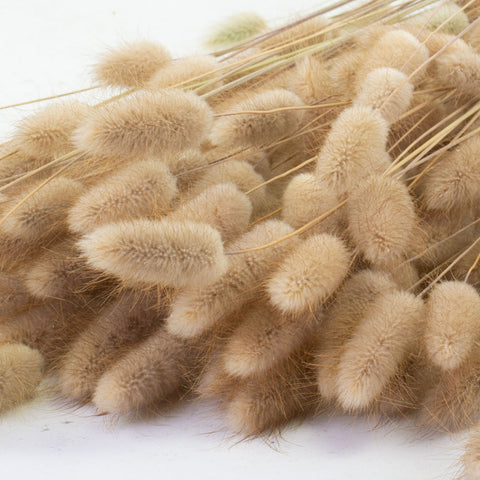
Is Bunny Tail Grass Annual or Perennial?
Bunny Tail Grass is classed as an annual, which means it completes its entire lifecycle in one growing season. From seed to flowering to seed production, it grows and dies back within the same year.
Will It Come Back?
Although it isn’t a true perennial, Lagurus ovatus can return the following year through self-seeding. If the plant is left to dry naturally in the garden, it often drops seeds that germinate the next spring, especially in mild or sheltered spots.
That said, regrowth isn’t guaranteed. Success depends on a few factors, including soil conditions, temperature, and whether seed heads are left undisturbed.
Is Bunny Tail Grass Invasive?
Bunny Tail Grass isn’t considered invasive in the UK, but it’s still worth planting responsibly. In some regions with dry, sandy soil and limited competition, self-seeding grasses can spread beyond intended borders.
To avoid unintended growth, harvest mature seed heads before they disperse, particularly if you’re growing near wildflower areas or open countryside.
Where Does Bunny Tail Grass Grow?
In the wild, Bunny Tail Grass (Lagurus ovatus) is native to coastal areas of the Mediterranean. It thrives in dry, sandy soils and open grasslands, where the warm climate and good drainage support its natural growth cycle.
Can Bunny Tail Grass Grow in the UK?
Although not native to Britain, Bunny Tail Grass adapts well to UK gardens, particularly in well-drained soil and sunny spots.
It’s often grown as an ornamental in borders, containers, and cutting gardens. In southern regions or during warmer summers, it may self-seed and reappear the following year.
If growing in cooler or wetter parts of the UK, it’s best treated as an annual and resown each spring.
Should You Forage or Grow It?
While you might occasionally see Bunny Tail Grass in naturalised patches or garden escapes, foraging isn’t recommended.
Wild grasses play a role in local ecosystems, and harvesting without permission may be damaging or restricted.
For floral use, it’s far more reliable and sustainable to grow it yourself or buy dried stems from a reputable supplier.
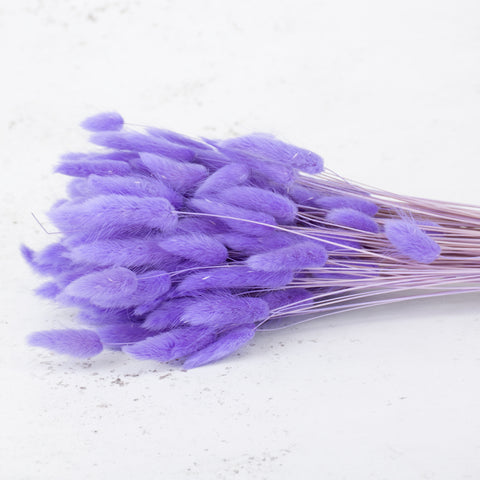
How to Grow Bunny Tail Grass
Bunny Tail Grass is easy to grow from seed and suits a range of garden styles, from sunny borders to containers on balconies or patios. Its compact size and low-maintenance nature make it ideal for beginners, florists, and home decorators alike.
When to Sow Bunny Tail Grass
Sow Bunny Tail Grass seeds in early to mid-spring, once the risk of frost has passed. You can start seeds indoors in seed trays or modules, then move them outside once established. Alternatively, sow directly into prepared soil if the ground is warm enough.
Germination usually takes 1–2 weeks.
Light, Soil, and Watering
This is a sun-loving plant that thrives in full light and well-drained soil. It prefers sandy or loamy conditions and doesn’t tolerate heavy, wet ground.
Water lightly but regularly during early growth. Once established, Bunny Grass is drought-tolerant and needs only occasional watering, especially if planted in the ground.
Growing in Pots or Containers
Bunny Tails grow well in pots, making them a good choice for small spaces. Use a container with good drainage and fill it with a free-draining compost mix. Avoid overwatering and allow the top layer of soil to dry out between watering sessions.
Position the pot in a sunny, sheltered spot to encourage strong, upright stems.
Indoor vs Outdoor Growing
While Bunny Tail Grass can be started indoors, it needs plenty of light to grow well. If you’re growing it inside permanently, place it near a south-facing window or under a grow light. Outdoors, it performs best in gardens or on balconies where it gets full sun and airflow.
In cooler climates, you can extend the season by moving pots indoors in autumn, although flowering is typically finished by then.
Flowering and Harvest Timeline
Bunny Grass usually flowers 60–90 days after sowing. You’ll start to see its characteristic fluffy heads appear in mid to late summer. Once mature, the seed heads can be harvested for drying or left to self-seed naturally.
When and How to Harvest & Dry Bunny Tail Grass
Drying Bunny Tail Grass at the right time helps preserve its colour, softness, and structure, making it suitable for long-lasting floral work. A few simple techniques can make all the difference to the finished look.
When to Pick Bunny Tails for Drying
- The ideal time to harvest is when the seed heads are fully formed but not yet starting to shed.
- Look for fluffy heads that have turned from pale green to a soft cream or beige. The stems should feel firm, and the shape of the inflorescence should be rounded and plump.
- If you leave them too long, the heads may become brittle or start releasing seeds, which can make them harder to preserve.
How to Cut and Bundle
- Use clean, sharp snips to cut stems low on the plant, ideally in the morning once any dew has dried.
- Group them into small, loose bundles — about 10 to 15 stems each — and secure with string or a rubber band.
- Keep the heads well spaced to prevent them from flattening or becoming misshapen as they dry.
Air-Drying Tips
- Hang your bundles upside down in a dry, well-ventilated space away from direct sunlight. A shaded loft, airing cupboard, or garden shed works well.
- Good airflow is key. Avoid any damp or enclosed areas, as these can cause mould or discolouration.
- Drying typically takes 10 to 14 days. The stems are ready when they feel crisp to the touch and hold their shape when gently moved.
Retaining Colour and Shape
- To keep the best natural colour, dry Bunny Tails in low light.
- Direct sun can bleach the heads, making them look flat or faded.
- If fluffiness is important for your design, avoid crushing or stacking the stems while they’re curing.
- Some florists use a light mist of unscented hairspray to help set the shape, especially if the stems will be handled frequently.
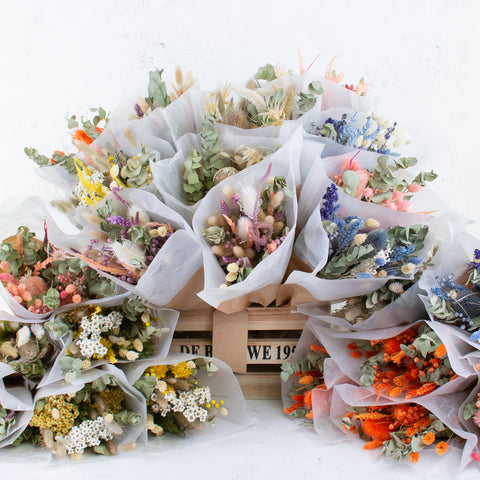
How Long Do Dried Bunny Tails Last?
Once dried, Bunny Tail Grass typically lasts between one and three years, far longer than fresh flowers, and with none of the ongoing maintenance. The actual lifespan depends on how and where it’s displayed.
Dried Bunny Tails don’t wilt, but they will gradually fade or lose fluff, especially in bright rooms or high-traffic areas.
You might notice the heads becoming more brittle after a year or two, or the stems losing their shape if they’re bent or rearranged often.
How to Look After Bunny Tails
Dried Bunny Tail Grass requires very little maintenance, but a few simple care steps will help preserve its softness, shape, and colour for as long as possible.
Care Tips for Long-Lasting Stems
To keep your Bunny Tails looking fresh for longer:
- Avoid direct sunlight to help preserve colour
- Keep away from moisture and humidity
- Dust gently every so often using a soft brush or a hairdryer on a cool, low setting
If a display starts to look tired, it’s easy to refresh it by replacing a few stems or combining with a new seasonal colour mix.
Where to Place Them
Keep Bunny Tails away from direct sunlight, as prolonged exposure can cause fading or brittleness. Moisture is another concern.
Bathrooms, kitchens, and windowsills can introduce damp or humidity that may affect the stems over time. Choose dry, shaded spots with good airflow for best results.
If displaying in a high-traffic area, avoid placing them where they might be knocked or bent. Repeated handling weakens the stems and shortens their lifespan.
Sustainable and Reusable
Dried Bunny Tail Grass is a low-waste option for styling and gifting. The stems can be reused year after year or rotated seasonally.
Once they’ve reached the end of their useful life, they’re biodegradable, making them a more eco-conscious alternative to synthetic decorations or cut flowers with a short lifespan.
Styling Ideas for Bunny Tail Grass
Bunny Tail Grass is an incredibly adaptable styling stem. Its soft, sculptural form works across interiors, weddings, and seasonal projects, lending shape, texture, and movement without overwhelming the space. Natural or dyed, dried or faux, these stems offer a simple way to elevate arrangements with a tactile, contemporary finish.
Wedding Florals
Bunny Tails bring softness and structure to wedding work. Neutral tones like Natural and Bleached White suit bridal bouquets, buttonholes, and archways. They also photograph beautifully against linen, lace, and seasonal foliage.
To introduce warmth or depth, try Terracotta, Burgundy, or Buff in table settings and venue arrangements.
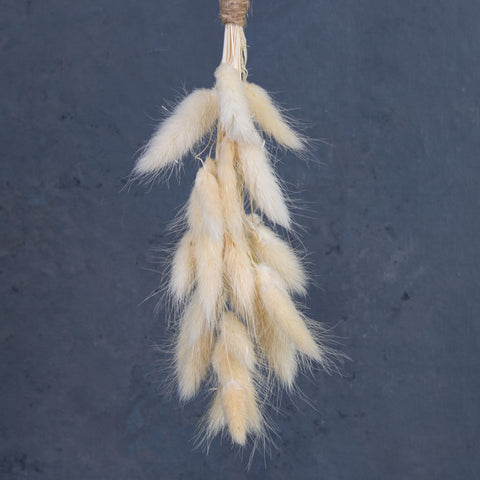
Vases, Shelves, and Tabletops
A simple vase of Bunny Tails can soften a space with minimal effort. For a neutral interior, options like Porcelain or Blue blend easily into clean palettes. For bolder styling, consider Red or Yellow.
Grouped in odd numbers at varying heights, they add texture to shelves, mantels, or tablescapes with a natural, effortless feel.
Seasonal Wreaths and Centrepieces
Bunny Tail Grass lends itself well to seasonal styling. Richer tones like Orange, Yellow, and Red work beautifully in autumn wreaths and winter centrepieces. For spring and summer, lighter shades such as Pink, Pastel Pink, and Blue complement softer palettes.
Fix to wire wreath bases or arrange in shallow bowls using floral foam or chicken wire for structure.
For ready-made designs, explore our dried wreaths collection. Looking for styling inspiration? Take a look at our Lagurus wreath ideas on Pinterest.
DIY Gifts and Decorative Projects
Bunny Tails make excellent additions to DIY crafts. Tied into small bundles, they suit gift wrapping, table favours, or card embellishments. Inside glass cloches or handmade flower frames, they hold their shape and colour for months.
Try pairing them with dried lavender, strawflowers, or mini statice to build layered textures in handmade pieces.

Other Bunny Tail Grass FAQs
What are Bunny Tails called?
Bunny Tail Grass is the common name for Lagurus ovatus, a Mediterranean ornamental grass known for its soft, fluffy seed heads. It’s sometimes also referred to as rabbit-tail grass or hare’s tail grass.
What’s the difference between Bunny Tail Grass and Pampas Grass?
Bunny Tail Grass (Lagurus ovatus) grows to about 30–60cm and has small, oval seed heads. Pampas Grass (Cortaderia selloana) is a much taller perennial with large, feathery plumes. Both are used in dried arrangements but offer very different scale and texture.
Can you dye Bunny Tails yourself?
Yes, Bunny Tails can be dyed using floral spray or fabric dye diluted in water. For best results, use dried stems and test colours on a small sample first to avoid oversaturation or colour bleed.
Is Bunny Tail Grass Safe for Pets?
Lagurus ovatus is not listed as toxic by the Royal Horticultural Society (RHS), and it also does not appear on the ASPCA’s list of harmful plants. However, it’s still best to keep dried florals out of reach of curious pets.
Cats in particular may be tempted to chew on the fluffy seed heads, which could pose a choking risk or cause digestive upset if ingested.
If pet safety is a concern, consider using faux Bunny Tails in areas that pets can access. High-quality artificial versions offer a similar aesthetic without the fragility, and no risk if nibbled!
What’s the difference between artificial and natural Bunny Tails?
Natural stems provide the best texture and colour variation for styling up close, while faux versions offer greater durability in commercial or high-humidity spaces. Faux Bunny Tails are also a safer choice where pets are present or where long-term handling is expected.
Add a Touch of Softness with Bunny Tail Grass
Bunny Tail Grass brings together form, function, and a distinctive softness that makes it a natural choice for dried arrangements.
Its sculptural heads offer movement and texture, working beautifully in bouquets, wreaths, or minimalist vase displays.
It’s also one of the easiest dried stems to work with. There’s no need to grow or harvest it yourself unless you want to. Atlas Flowers offers a wide selection of ready-to-use dried Bunny Tail Grass, available in a spectrum of colours to suit every palette and purpose.
From natural tones to soft pastels and bold brights, each bunch is carefully sourced, dried, and prepared to meet the needs of florists, stylists, retailers, and home decorators alike.
Share Your Makes!
We hope that you’ve enjoyed looking into the world of lagurus and have been inspired to create something wonderful. It would be lovely to see your bunny tail projects! Why not head over to our socials and share or tag your makes?
